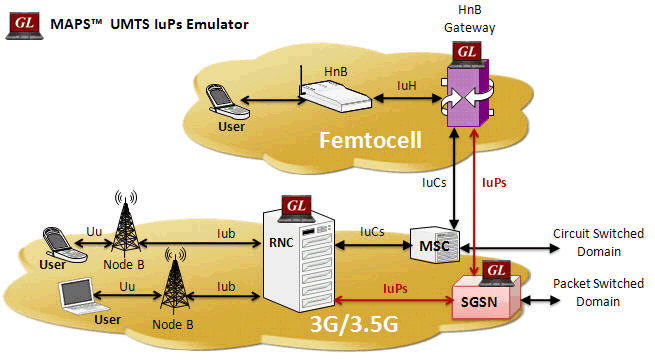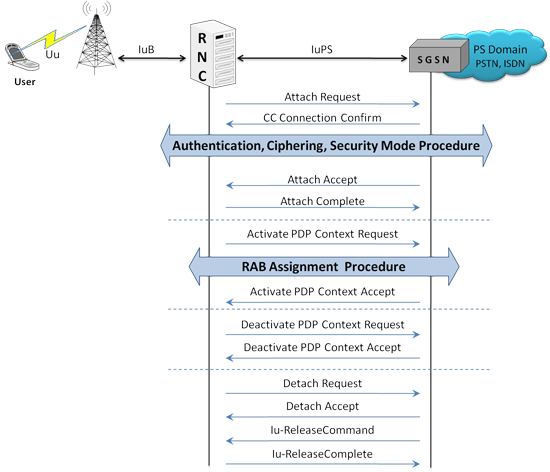GL Announces Enhanced UMTS IuPS Interface Emulator
Welcome to another March 2013 issue of GL's Newsletter providing information and insight into our latest enhancements to MAPS™ UMTS IuPS Interface Emulator. In essence, UMTS IuPS is the Gateway to the World Wide Web. More precisely, IuPS, as shown below, is the interface between the RNC (Radio Network Controller) and the SGSN (Serving GPRS Support Node). It's what makes smartphones "smart", and a giant step in mobile technology evolution, dramatically changing the way we work and play.

Overview
UMTS, or Universal Mobile Telecommunications System is a 3rd generation mobile technology – evolved from GSM technology. It uses W-CDMA (Wideband Code Division Multiple Access) radio access. With increased spectral efficiency and high bandwidth, UMTS can support broadband data, voice, and video. The underlying transport for UMTS in the core network can be Asynchronous Transfer Mode (ATM) or IP. UMTS supports integrated services such as multimedia and global roaming to mobile users.
SGSN manages mobile location whether within the carrier's network or roaming outside. Once a user turns on his or her mobile, a new IP address gets assigned and IP connectivity is available with quality of service (bit rate allocation) based on subscription, and tunnels are created for mobile flows to/from that mobile. These data tunnels carry encapsulated traffic such as http, ftp, email, etc. SMS may also be carried by the signaling plane to/from the mobile. IuPS emulation and analysis can be very important in the design, verification, and troubleshooting of a carrier's mobile data network.
GL's Message Automation & Protocol Simulation (MAPS™), is a protocol simulation and conformance test tool that supports a variety of protocols such as SIP, MEGACO, ISDN, SS7, GSM, LTE, and many other TDM, IP, and Wireless protocols. MAPS™ has been enhanced for testing UMTS IuPS interface. It can simulate RNC (Radio Network Controller), and 3G SGSN (3G Serving GPRS Support Node) by generating RANAP and DTAP signaling messages over SCTP as Transport layer in an IP network as defined by 3GPP standards. MAPS™ provides users the unlimited ability to edit messages and control scenarios (message sequences). "Message sequences" are generated through scripts. "Messages" are created using message templates.
Call Generation

Typical Call Flow between the UMTS IuPS network entities
Call Generation option allows the user to simulate outgoing communications where an outgoing call is initiated by sending call control messages using proper scripts and profiles. The profile allows necessary parameters of call control messages to be changed during runtime. Messages are exchanged between MAPS™ and the DUT. MAPS™ application acts as either the Caller or resides at the network terminal acting as Callee.
In this document, we are considering the call flow between the RNC and SGSN nodes for Attach Request and Routing Area Updating (RAU) procedures.
Testing SGSN (Attach Procedure)
As depicted in figure below, MAPS™ - IuPS acts as RNC processing the call flow and responds to messages from SGSN Node. The MAPS™ initiates the Attach Procedure by sending Attach Request to the DUT (SGSN). The DUT on receipt of ATTACH REQUEST message should send a CC connection confirm message in response as shown in the figure below.

MAPS™ UMTS IuPS configured as RNC
Call Reception
Call generated from another entity can be automatically detected in call reception window by setting the required scripts against expected messages in the Incoming Call Handler window.
Testing RNC
As seen in the figure below, MAPS™ acts as SGSN, and tests the DUT that is configured as RNC. This test is performed to ensure that the MAPS™ (SGSN) on receipt of ATTACH REQUEST message from RNC, sends a CC connection confirm message in response. MAPS™ responds to the messages received from RNC and then completes the call flow.

MAPS™ UMTS IuPS configured as SGSN
Main Features – IuPS Emulator
- Simulates RNC and SGSN entities
- Generates and supports all Mobility Management, Session Management, RANAP and DTAP messages
- User controlled access to RANAP and DTAP messages
- Ready scripts for Routing Area Updating, GPRS Attach, and Detach procedures for quick testing
- Supports Authentication, TMSI Reallocation, Encryption, and other optional procedures
- Supports mobile traffic simulation with additional licenses
- Provides fault insertion and erroneous call flows testing capability
- Impairments can be applied to messages to simulate error conditions
- Supports customization of call flows and message templates using Script editor and Message editor
- Supports scripted call generation and automated call reception
- Provides detail protocol trace with full message decoding and graphical ladder diagrams of call flow with time stamp
- Call flow graph allows to easily verify the messages exchanged with DUT
- Displays call status, results, call information, total iterations to be done, and completed iterations
- Script based and protocol independent software architecture
- Provides call statistics and associated captured events and error events during call simulation
Traffic Options - Mobile Traffic Core
Mobile traffic core module supports user-plane traffic simulation in LTE and UMTS network. Following module types are supported -
- Mobile Traffic Core - GTP (ETH101) - This module supports user-plane packet transmission and reception services between any two nodes (GTP-U protocol entity) in UMTS (SGSN, GGSN, RNC), and LTE (SGW, PDNGW) networks. This module can support generation and verification of data traffic such as Email, FTP, Web (HTTP), Video, and more. This module also allows simulation of multiple users accessing a Web server simultaneously.
- Mobile Traffic Core - Gateway (ETH102) - This module allows simulation of Gateway and transfers user plane data from RNC to GGSN. It handles GTP tunnels on both directions of SGSN. It can also act as GGSN for userplane traffic by encapsulating IP traffic over GTP.

???: any IP-based protocol used to carry packet radio service
HTTP: Hypertext Transfer Protocol
GTP: GPRS Tunneling Protocol
Mobile Traffic Core Protocol Stack
Call Statistics
By default, all call handling scripts (irrespective of the type of the functions) are assessed by MAPS™ to provide statistical information about Total Calls, Active Calls, Completed Calls, Passed Calls, Failed Calls, and Calls/Sec . It is also possible to characterize the statistical information under different groups of call handling scripts under a unique heading. In addition, Call Generation and Call Reception windows provide useful call status & script execution results.
For comprehensive information on the application, you can refer to the MAPS™ UMTS IuPS Interface Emulator web page.
 Back to Newsletter Index Page
Back to Newsletter Index Page